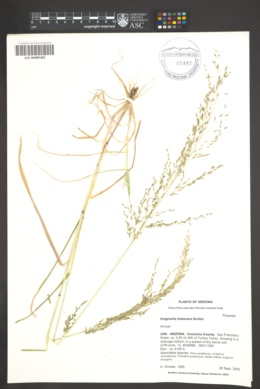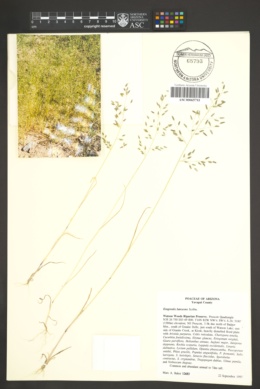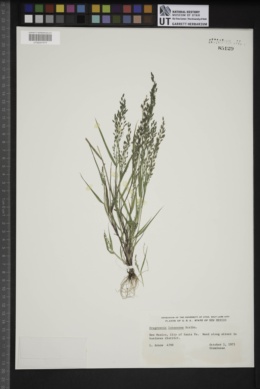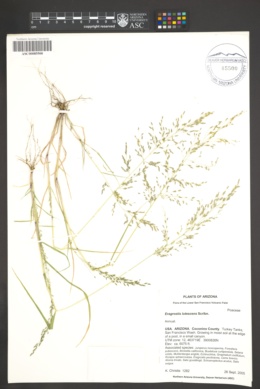Eragrostis lutescens
|
|
|
|
Family: Poaceae
Six-Weeks Love Grass, more...sixweeks lovegrass
|
Plants annual; tufted, without innovations. Culms (2)6-25 cm, usually erect, sometimes decumbent, glabrous, with elliptical, yellowish, glandular pits below the nodes. Sheaths with elliptical glandular pits, sparsely hairy at the throat, hairs to 2 mm; ligules 0.2-0.5 mm, ciliate; blades 2-12 cm long, 1-3 mm wide, flat to involute, abaxial surfaces scabridulous, bases with glandular pits. Panicles terminal, 4-10(15) cm long, 0.5-2 cm wide, narrowly elliptic, contracted, dense; primary branches alternate, usually appressed, occasionally diverging to 30° from the rachises, rachises and branches with glandular pits; pulvini glabrous; pedicels 1.4-10 mm, appressed or divergent. Spikelets 3.6-7.5 mm long, 1.2-2 mm wide, narrowly ovate, light yellowish, occasionally mottled with reddish-purple, with 6-11(14) florets; disarticulation acropetal, paleas persistent. Glumes subequal, ovate to lanceolate, hyaline; lower glumes (0.7)0.9-1.4 mm; upper glumes 1.2-1.8 mm; lemmas 1.5-2.2 mm, ovate, subhyaline, stramineous, veins greenish and conspicuous, apices acute; paleas 1.2-2 mm, hyaline, keels scabridulous, apices obtuse; anthers 3, 0.2-0.3 mm, purplish. Caryopses 0.5-0.8 mm, pyriform except slightly flattened adaxially, smooth, light brown. 2n = unknown. Eragrostis lutescens grows on the sandy banks of streams and lakes and in moist alkaline flats of the western United States at 300-2000 m. It has not been reported from Mexico. FNA 2003, Gould 1980 Common Name: sixweeks lovegrass Duration: Annual Nativity: Native Lifeform: Graminoid General: Tufted annuals; not rhizomotous with erect, sometimes decumbent culms, glabrous, (2)6-25 cm with elliptical, yellowish, glandular pits below the nodes. Vegetative: Sheaths with elliptical glandular pits, sparsely hairy at the throat, hairs to 2 mm; ligules 0.2-0.5 mm, ciliate; blades 2-12 cm long, 1-3 mm wide, flat to involute, abaxial surfaces scabrous, bases with glandular pits. Inflorescence: Panicles terminal, 4-10(15) cm long, 0.5-2 cm wide, narrowly elliptic, contracted; primary branches usually appressed or diverging to 30-, rachises and branches with glandular pits; pulvini glabrous; pedicels 1.4-10 mm, appressed or divergent; spikelets 3.6-7.5 mm long, 1.2-2 mm wide, narrowly ovate with 6-11(14) florets; disarticulation at the base, paleas persistent; glumes subequal, ovate to lanceolate, hyaline; lower glumes (0.7)0.9-1.4 mm; upper glumes 1.2-1.8 mm; lemmas 1.5-2.2 mm, ovate, subhyaline, stramineous, veins greenish and conspicuous, apices acute; paleas 1.2-2 mm; caryopses 0.5-0.8 mm, pyriform except slightly flattened adaxially, smooth, light brown. Ecology: Sandy banks of streams and lakes and in moist alkaline flats; 984 - 6561 ft (300-2000 m). Distribution: NM west to CA and north to WA and ID. Notes: Distinguished by being a rather shorter annual bunch grass to 25 cm with a condensed panicle, multiple florets per spikelet that turn yellow, glandular pits on culms and leaf sheathes (use hand lens), and ciliate ligules. Ethnobotany: unknown Etymology: Eragrostis is from Greek eros, love and agrostis, grass. Lutescens is derived from latin meaning -turning yellow- and likely refers to the yellowish spikelets. Synonyms: None Editor: FSCoburn 2014 |




































